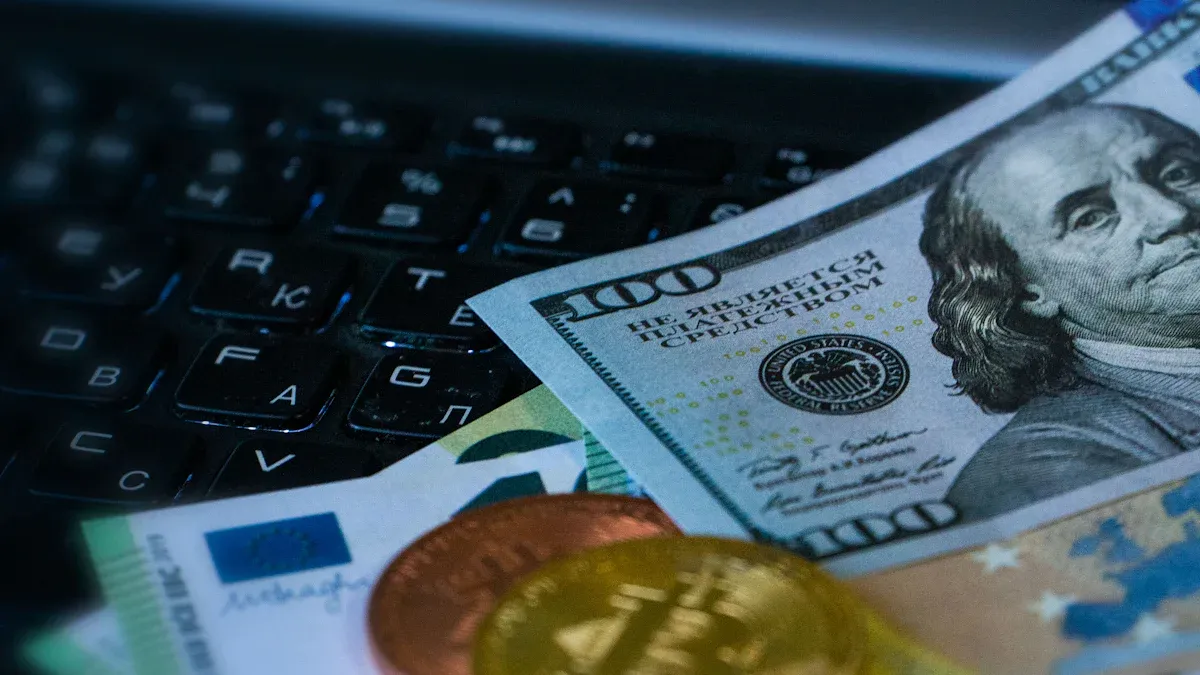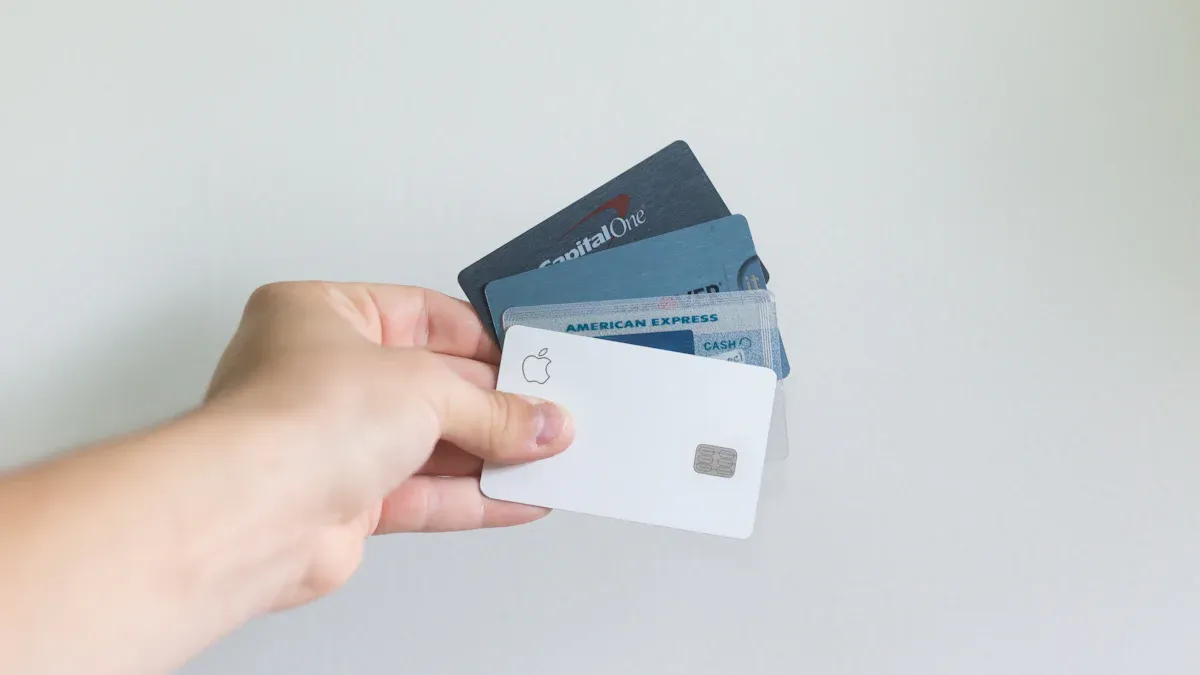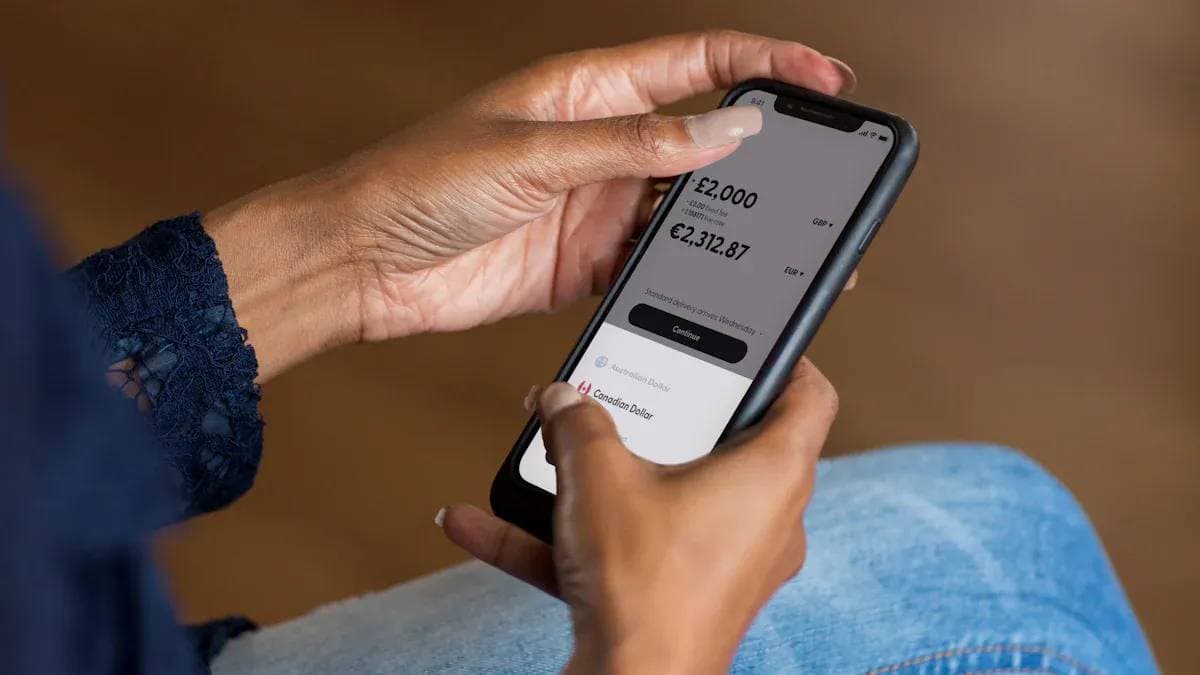- EasyCard
- Trade
- Help
- Announcement
- Academy
- SWIFT Code
- Iban Number
- Referral
- Customer Service
- Blog
- Creator
Money-Saving Secrets for Overseas Spending: Which is More Cost-Effective, DCC or Foreign Transaction Fees?

Image Source: pexels
When swiping your card for overseas spending, remember one golden rule: always choose to settle in the local currency. This choice directly impacts your travel cross-border payment costs.
Choosing to pay in your familiar home currency (such as RMB) may seem convenient, but it is actually an expensive trap. This service, known as DCC (Dynamic Currency Conversion), will cause you to unknowingly pay 3% to 5% or even higher additional fees.
This article will reveal the cost differences behind this and provide a practical guide to avoiding pitfalls.
Key Points
- When swiping your card abroad, choose to pay in the local currency to save money.
- DCC (Dynamic Currency Conversion) service will make you spend more because it uses unfavorable exchange rates.
- By choosing local currency payment, you only need to pay a lower bank fee.
- When paying, tell the clerk to settle in the local currency and carefully check the currency on the receipt.
- Using credit cards with no foreign transaction fees or high cashback can make your overseas spending more cost-effective.
DCC vs. Foreign Transaction Fees: Cost Comparison

Image Source: pexels
To make you fully understand why choosing the local currency is always wiser, we need to deeply analyze the fee structures behind the two options. Once you see the composition of the bill, you will understand how DCC services quietly make you spend more.
Fee Structure Revealed
When you swipe your card, the payment system provides two completely different pricing paths. Your choice will directly determine the final expenditure.
Path One: Choose “Local Currency” Settlement
This is the method we strongly recommend. When you choose to pay in the local currency (such as euros, yen, baht), the fee structure is clear and transparent.
- Final Payment Amount = (Transaction Amount x International Card Organization Exchange Rate) + Foreign Transaction Fee
The key points here are:
- Exchange Rate Setter: Determined by international card organizations such as Visa or Mastercard. Their exchange rates are very close to real-time interbank rates with very low markups. For example, Visa’s exchange rate markup is usually only about 0.218%, while Mastercard’s is about 0.282%.
- Additional Fees: Your issuing bank (for example, a licensed bank in Hong Kong) may charge a “Foreign Transaction Fee,” usually around 1.5%. This fee mainly covers the bank’s cost of processing foreign currency transactions.
In simple terms: You use a very fair exchange rate and then pay a clear fee. The total cost is predictable and relatively low.
Path Two: Choose “Home Currency” Settlement (DCC)
When you see the familiar USD amount displayed on the POS machine and select it, you activate the DCC (Dynamic Currency Conversion) service.
- Final Payment Amount = Transaction Amount x DCC Provider’s Custom Exchange Rate (Including Service Fee)
The trap here is:
- Exchange Rate Setter: No longer Visa or Mastercard, but determined by the DCC service provider (usually a third-party financial institution cooperating with the merchant).
- Additional Fees: DCC fees are usually not explicitly listed as “fees” but directly embedded in a very unfavorable exchange rate. This rate includes 2%-5% or even higher markup fees and transaction processing fees.
According to Visa’s requirements, merchants must clearly inform the related markup fees when using DCC, but this information is easily overlooked in actual operations. The DCC provider’s exchange rate markup is astonishing, usually around 7%, and in extreme cases, it can even reach 18%.
The table below allows you to more intuitively see the cost differences between the two paths:
| Comparison Item | Choose Local Currency | Choose Home Currency (DCC) |
|---|---|---|
| Exchange Rate Provider | International Card Organizations (Visa, Mastercard) | DCC Service Provider |
| Exchange Rate Advantage | ✅ Fair rate, close to market price | ❌ Poor rate, includes high markup |
| Fee Structure | Card organization rate + Bank fee (about 1.5%) | DCC custom rate (includes 3%-7% service fee) |
| Transparency | Higher, fees usually listed on the bill | Lower, fees hidden in the rate |
| Total Cost | Lower | High |
Spending Example Calculation
Theoretical knowledge may be a bit dry; let’s calculate through a specific example to see exactly how much more DCC will cost you.
Assume you purchase an item worth $1,000 USD in a store in Europe. The credit card you use is issued by a licensed bank in Hong Kong, which charges a 1.5% foreign transaction fee.
Scenario One: You Choose to Pay in "Local Currency"
You tell the clerk: “Please charge in local currency.” Your credit card bill will be calculated as follows:
- Transaction Principal: $1,000 USD
- Foreign Transaction Fee: $1,000 USD x 1.5% = $15 USD
- Final Billed Amount: $1,000 USD + $15 USD = $1,015 USD
In this mode, your total cost is $1,015 USD. The entire calculation process is clear and straightforward.
Scenario Two: You Choose the “USD” Amount Displayed on the POS Machine (DCC)
The POS machine pops up an option, and for convenience, you directly select to pay in USD. At this point, the DCC service provider takes over the transaction. We assume this DCC service provider charges a 5% comprehensive service fee (this is a relatively conservative figure).
- Transaction Principal: $1,000 USD
- DCC Service Fee/Exchange Rate Markup: $1,000 USD x 5% = $50 USD
- Final Billed Amount: $1,000 USD + $50 USD = $1,050 USD
Through DCC, your total cost becomes $1,050 USD. You will not receive a separate fee bill because this extra $50 USD is completely integrated into the total amount you confirm for payment.
The conclusion is clear at a glance:
$1,050 (DCC) - $1,015 (Local Currency) = $35 USD
Simply because you made a different choice when paying, this $1,000 USD purchase cost you an extra $35 USD. This money did not exchange for any additional goods or services and is a completely avoidable cost. Optimizing your travel cross-border payments starts with rejecting DCC.
Avoiding DCC Traps: Practical Guide
Theoretical knowledge lets you understand the expensiveness of DCC; now you need to master how to perfectly avoid it in the real world. Follow these three simple steps, and you can ensure every overseas purchase is worth the money.
Proactive Statement When Paying
Prevention is the best strategy. Do not wait for the clerk or POS machine to give you a choice; take the initiative and control the conversation.
- Clearly Express Your Intent: When handing over your credit card, immediately and clearly tell the cashier that you want to pay in the local currency.
- Learn Key Phrases: A simple English sentence can solve the problem. You can look at the cashier, smile, and say:
“Charge in local currency, please.” (Please settle in local currency.)
If in Europe, you can say “Pay in Euros, please”; in Japan, say “Pay in Yen, please”. This simple statement can avoid most DCC transactions caused by the cashier’s “habitual” operations.
Careful Verification of the Credit Card Slip
Before you enter your PIN or sign, you have one last chance to check. The credit card slip is your line of defense; please take a few seconds to inspect it.
The core information you need to check is the currency of the transaction amount.
- Look for Currency Indicators: Carefully check the currency symbol or code displayed next to the total amount on the slip. You should see the local currency indicator, such as the euro symbol € or code EUR in Europe; the pound symbol £ or code GBP in the UK; the dollar symbol $ or code USD in the US. Receipts usually use currency symbols, while ISO 4217 currency codes (such as GBP for pound) may appear in more formal transaction records.
- Beware of Your Home Currency: If you are spending in Europe but see the total priced in USD or CNY on the slip, this almost 100% means DCC has been activated.
Let’s look at a real credit card slip data comparison. Assume a 20 euro purchase, the actual costs under different choices:
| Transaction Type | Final Payment Amount (GBP) | Extra Paid vs. Market Rate (GBP) | Extra Paid Percentage |
|---|---|---|---|
| DCC (Choose GBP Payment) | £16.75 | £0.96 | 6.1% |
| Local Currency (Choose Euro Payment) | £16.44 | £0.65 | 4.1% |
Key Reminder: If the amount on the slip is not in the local currency, you have the right and should ask the merchant to cancel this transaction (
cancel this transaction) and redo it in the local currency.
Remedies After Choosing Wrong
People always have moments of oversight. If you accidentally choose wrong or discover the issue only when checking the slip, what should you do?
- Best Timing: Handle It On the Spot This is the most effective method. If the transaction has just been completed, immediately explain the situation to the merchant. You can politely say: “Sorry, I think I chose the wrong currency. Can we cancel this transaction and redo it in local currency?” (Sorry, I seem to have chosen the wrong currency. Can we cancel this transaction and redo it in local currency?) Most legitimate merchants will be willing to cooperate.
- Contact the Bank Afterwards: Slim Hope Once you leave the store and the transaction data is uploaded, things become complicated. Although you can try contacting your issuing bank, the success rate is very low. From the bank’s perspective, this is a valid transaction authorized by you (through signature or PIN). Banks usually do not intervene in exchange rate issues between you and the DCC provider.
Therefore, placing hope in post-remedies is far less effective than staying vigilant in the dozens of seconds during payment. Mastering these practical skills will make you more confident in every travel cross-border payment.
Optimizing Travel Cross-Border Payments: Strategies and Choices

Image Source: unsplash
Smartly avoiding DCC is just the first step in saving money. To further optimize your travel cross-border payment strategy, you need to select the most suitable tools for your wallet. Credit cards, cash, and electronic payments each have advantages; combining them makes you a true money-saving expert.
Selected Credit Cards: No Fees and High Cashback
Choosing the right credit card can minimize the cost of overseas spending or even achieve “reverse earning.” There are mainly two types of cards worth your attention:
-
Credit Cards That Waive Foreign Transaction Fees These cards directly waive the approximately 1.5% bank fee. When you choose to settle in local currency, your cost is only the international card organization’s exchange rate, which is one of the most cost-effective solutions. For example, some credit cards issued by Industrial and Commercial Bank of China offer this benefit:
Credit Card Name Overseas Transaction Fee ICBC Preferred UnionPay Gold Card None ICBC Premium UnionPay Platinum Card None ICBC Preferred Visa Card None ICBC Premium Visa Signature Card None -
High-Rate Overseas Spending Cashback Credit Cards Some credit cards charge a 1.5% fee but offer higher overseas spending cashback, such as 2% or more. This way, you not only offset the fee but also net a 0.5% cashback.
Money-Saving Tip: When using these cards, your net benefit =
Cashback Rate - Foreign Transaction Fee. As long as the cashback rate is higher than the fee, the transaction is “profitable.”
Beyond Credit Cards: Cash and Electronic Payments
Credit cards are not all-powerful. In your travel cross-border payment toolbox, cash and electronic payments are equally indispensable.
- Cash: An Indispensable Traditional Tool In some countries, cash is still king. For example, in Germany, Egypt, and Romania, most daily transactions are still completed in cash. Carrying an appropriate amount of cash for small payments, visiting markets, or patronizing small shops that do not accept cards is very necessary. But please note that carrying large amounts of cash poses security risks.
- Electronic Payments: Emerging Convenient Choices Mobile payments represented by Alipay and WeChat Pay are accelerating globalization. Now, you can bind international credit cards like Visa and Mastercard to these apps and scan to pay at overseas cooperating merchants. In specific regions, using electronic wallets cooperating with locals may be more favorable. For example, using an electronic wallet app cooperating with PayPay in Japan not only enjoys favorable exchange rates but may also receive additional discounts and points, sometimes more cost-effective than swiping a credit card.
Looking ahead, with the development of central bank digital currencies (CBDC), such as the mBridge project connecting mainland China, Hong Kong, Thailand, and the UAE, future cross-border payments are expected to become faster and lower cost.
Remember, when swiping your card overseas, choosing “local currency” settlement is your first principle and iron rule for saving money.
You can flexibly combine no-fee credit cards, electronic payments, and a small amount of cash based on the habits of your destination (whether cash-preferred Europe or diverse payment methods in Southeast Asia). By carefully selecting your payment tools, you can maximize savings.
Wishing you a pleasant trip and the satisfaction from every smart purchase!
FAQ
Why do merchants offer DCC services?
Merchants offer DCC services to earn commissions. DCC service providers share a portion of the fees with merchants. This extra income incentivizes merchants to recommend this service to you. Your convenience becomes the merchant’s profit source.
Do I need to watch out for DCC when withdrawing cash from ATMs?
Yes, ATM withdrawals also have DCC traps. When withdrawing, be sure to choose “without currency conversion” or the option priced in “local currency.” This ensures you get a fairer exchange rate and avoid unnecessary losses.
What if the POS machine forces DCC?
You can completely refuse this transaction.
- Politely ask the clerk to cancel the transaction and retry in local currency.
- If they cannot operate, you can switch to another card or pay directly in cash.
Remember, you have the right to choose the most advantageous payment method.
Do UnionPay cards have DCC issues?
UnionPay card transactions usually directly use the UnionPay exchange rate converted to RMB for billing. You generally will not encounter the DCC currency selection interface. UnionPay’s exchange rate is relatively transparent and is a worry-free choice. But it is recommended to confirm before traveling whether your card waives currency conversion fees.
*This article is provided for general information purposes and does not constitute legal, tax or other professional advice from BiyaPay or its subsidiaries and its affiliates, and it is not intended as a substitute for obtaining advice from a financial advisor or any other professional.
We make no representations, warranties or warranties, express or implied, as to the accuracy, completeness or timeliness of the contents of this publication.




Contact Us
Company and Team
BiyaPay Products
Customer Services
is a broker-dealer registered with the U.S. Securities and Exchange Commission (SEC) (No.: 802-127417), member of the Financial Industry Regulatory Authority (FINRA) (CRD: 325027), member of the Securities Investor Protection Corporation (SIPC), and regulated by FINRA and SEC.
registered with the US Financial Crimes Enforcement Network (FinCEN), as a Money Services Business (MSB), registration number: 31000218637349, and regulated by FinCEN.
registered as Financial Service Provider (FSP number: FSP1007221) in New Zealand, and is a member of the Financial Dispute Resolution Scheme, a New Zealand independent dispute resolution service provider.



















